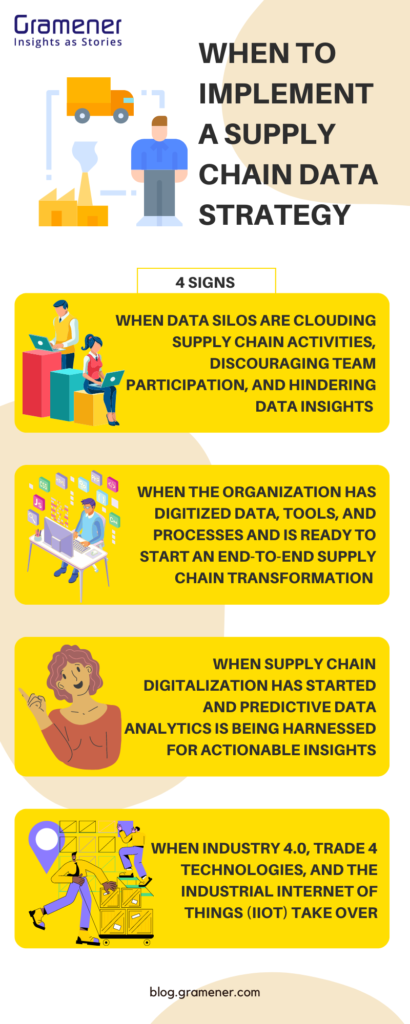Note: This is the 3rd article in the 5-part “Supply Chain Data Strategy” series, a strategy to empower supply chain leaders on the value of data-driven decision making.
Recap: In our previous article (2nd part) we talked about why you need a supply chain data strategy and how a good strategy will enable you to effectively interpret the data at hand and set yourself apart from the industry’s competition.
Precap: In this article, we’ll take things a step further and discuss when it’s appropriate to put your supply chain data strategy into practice and how you can use predictive data analytics to improve the supply chain.
Check out other parts of the series:
- What is supply chain data strategy (Part 1)
- Why you need supply chain data strategy (Part 2)
- 6 unsolicited tips to build the best supply chain data strategy (Part 4)
- How to implement your supply chain data strategy (Part 5)
In a constantly evolving and progressive world, everything is connected. The Fourth Industrial Revolution is witnessing a fusion of the physical, digital, and biological worlds, and we can be in control of the dizzying changes only if we collaborate. This is even truer for supply chain management as the ecosystem is undergoing digital transformation at scale.
Some enterprise scenarios call for immediate action to reset your data-enabled supply chain strategy at different stages of your supply chain data evolution.
Table of Contents

1. When data silos are clouding supply chain activities, discouraging team participation, and hindering data insights
It will help if you accelerate your efforts to adopt a data-enabled supply chain strategy at this stage. To break free from a linear supply chain, one must move towards a unified data goal and make data sharing an enterprise-wide policy. Tear down data silos, centralize and integrate your data, and use a cloud-based data warehouse solution. There are many software platforms and techniques to do this.
2. When the organization has digitized data, tools, and processes and is ready to start an end-to-end supply chain transformation
This time is ripe for revamping the supply chain data analytics approach with an updated vision attuned to recent business, industry, and technology developments. A long-term transformation roadmap is drawn up based on an assessment of current performance. Hiring talent to set up a supply chain Centre of Excellence with unified data to lead change and promote innovation is essential. At this point, bridging technology gaps with the latest analytics solutions will aid transformation, which should include speculative changes and no-regrets improvements.
3. When supply chain digitalization has started and predictive data analytics is being harnessed for actionable insights, it is better to fine-tune your supply chain data strategy for very specific business outcomes.
Predictive data analytics of the supply chain investigates past and present trends and combines the findings with business intelligence, market forecasts, and weather forecasts to recommend solutions. AI/ML-based solutions for supply chain data efficiency and maintenance are used to automate and optimize the supply chain in many ways.
Using Predictive Data Analytics to Optimize the Supply Chain
Let us look at the following examples.
- Demand Forecasting: A snowstorm is coming up in Alabama. That the demand for snow shovels will go up is gut-feeling and can, at best, help stock up inventory. Deploying predictive data analytics across the supply chain will throw up suggestions on diversifying products to offer snowplows and snow blowers, for instance, and throw in discount offers for weekend shoppers to maximize sales. Combine this with data on historical sales, snow clearance methods, and shopping patterns – you have a winner.
- Pricing Strategies: Raw material butadiene, used to make synthetic rubber, makes up 80% of the product cost structure. The commodity price fluctuations of butadiene are linked to oil output decisions, demand and supply, political developments, and the global economy. Predictive data analytics can forecast pricing through machine learning and help to reduce procurement costs for the tire manufacturer who uses butadiene. At the same time, price adjustments can be passed on to tire consumers in the auto industry.
- Inventory Management: To maintain inventory at the optimal level is to satisfy demand while reducing stock. Predictive data analytics across a supply chain can determine inventory needs by location and usage patterns with replenishment plans that factor in transport costs, material handling, storage capacity, and vendor lead times -for multiple points such as distributor, retail store, or distribution center. The transfer of products from over-stocked shop shelves to under-stocked stores can also be done.
- Shipping and Logistics: Simulating daily schedules and processes helps to optimize shipping and logistics operations. Predictive data analytics can detect unexpected conditions, short-term behavioral changes, and specific time-sensitive developments in the news, weather, routes, and supply and demand conditions. AI in supply chain management provides these insights. They can be acted upon at minimal cost, with real-time adjustments to shipping schedules, route optimization, transportation lead times, and the rebalancing of assets across the logistics network.
- Maintenance: Predictive data analytics facilitates supply chain maintenance through predictive monitoring of equipment and plant machinery. By leveraging past and continuous data, ML in supply chain management can reduce downtime, maximize asset lifetime, and boost uptime or operational efficiency. Machine learning can predict the remaining useful life, schedule advance maintenance, detect anomalies and give early warnings of component failure.
It is evident that when the flow of physical goods is faster than the flow of information about them, it is time to break down data silos, embark on supply chain digitalization, and initiate predictive analytics of your supply chain.
But there is another evolving situation in which the flow of data and information and resultant insights is faster than the flow of physical goods due to embedded technologies that have revolutionized supply chain transparency, production process visibility, and even business decision-making.
4. Welcome to Supply Chain 4.0: When Industry 4, Trade 4 technologies, and the Industrial Internet of Things (IIoT) take over
This is a juncture when the supply chain across industries will have data information flowing in rapidly from the Internet of Things (IoT) sensors. You must be ready with a Supply Chain 4.0 version of your supply chain data strategy.
There are estimates that by 2025, IoT-connected devices will amount to 30.9 billion globally, and the IIoT market may grow to USD 1.1 trillion by 2028.
The data aggregated from smart sensors have the power to transform your supply chain by tracking, authenticating, monitoring, identifying, and managing your goods – both stored and in movement. This means your supply chain data strategy can:
- Incorporate route planning to optimize speed and reduce damage
- Plan for remedies if there is a loss or delay
- Improve quality management by optimizing the storage of both raw materials and products
- Precisely locate goods, both when in transit and at rest in warehouses
- Efficiently store and distribute goods from warehouses
- Simplify supply and demand planning with clarity on goods’ arrival and processing timelines
- Anticipate last-minute changes to accommodate fresh needs without disruption
- Reduce extra inventory due to accurate demand predictions
- Anticipate and prepare for forecasted contingencies without guesswork
- Create a future roadmap to benefit from related Industry 4.0 technologies like AI/ML, blockchain, Digital Twins, and cyber-physical technologies like smart factories, smart warehouses, 3-D printing, collaborative robots, Edge computing devices, and so on.
From disparate data to actionable supply chain insights – the path to achieving a robust supply chain involves several steps. Investing organizational efforts into building supply chain data strategy helps work through these steps. A good strategy will give an organization the ability to draw meaning from the data within the supply chain and convert it into actions.

